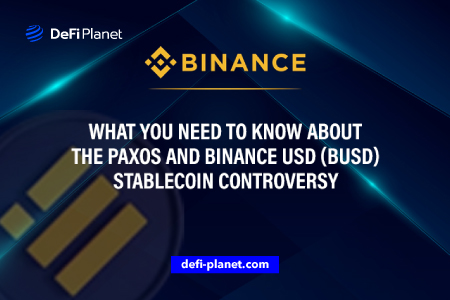As is fast becoming a trend in the crypto regulatory space, the US Securities and Exchange Commission (SEC), has again clamped down on another crypto organisation, Paxos—a leading blockchain infrastructure and stablecoin issuer, through a lawsuit filed on grounds related to its issuance of BUSD.
Before delving into the substance of the Paxos-BUSD case and its implications for the crypto industry, it is essential to provide an overview of what stablecoins are.
Stablecoins are a type of cryptocurrency that imitate the fixed nature of fiat currency and are typically pegged to the value of a fiat currency like the US dollar. They are also usually less volatile than regular cryptocurrencies such as Bitcoin and Ethereum.
To understand more about stablecoins, their uses and types, peruse through our previous article on the topic.
Using the SEC vs. Paxos controversy as a case study, this article will offer a comprehensive discourse on the challenges of compliance and regulation in the cryptocurrency industry, with emphasis on the legal challenges facing it, the existing regulations for stablecoins, as well as the future of stablecoin regulations and its implications for traders, investors and the wider crypto market.
TL:DR
- The crypto industry is closely monitoring recent developments in the stablecoin space, as the SEC has taken legal action against leading stablecoin issuer, Paxos on grounds that the BUSD stablecoin is an unregistered security.
- There are high prospects for more future regulations in the crypto space. While the Paxos lawsuit has raised questions on classifying stablecoins and other cryptocurrencies as “securities,” there has been a general call for the SEC to provide more precise guidelines to help industry players.
- Stablecoins would play a very significant role in the international adoption of cryptocurrencies, especially if recognised as CBDCs, so it is very crucial for the SEC and other regulatory authorities, as well as key players to properly navigate and improve the regulatory sphere of the crypto industry.
What Birthed The Paxos-BUSD Controversy?
On February 13, 2022, Paxos Trust Co, the issuer of Binance USD (BUSD), received a Wells notice from the US Securities and Exchange Commission (SEC), adding the organization to the list of crypto organizations currently facing regulatory scrutiny.
In this notice—which is basically a letter served by the regulator to inform companies of a planned enforcement action— the SEC indicated that BUSD is a security and that Paxos should have registered the token under federal securities laws, implying that the stablecoin is an unregistered security.
This comes on the heels of the SEC’s recent settlement with the crypto exchange Kraken. The securities regulator alleged that Kraken engaged in offering unregistered securities through its staking services forcing the company to shut down the service.
Following the notice, the New York Department of Financial Services (NYDFS), upon investigations, also revealed blockchain data showing that Binance did not have enough reserves to back up the BUSD tokens it had issued through Paxos and, thus, promptly ordered the blockchain company to stop the minting and issuance of BUSD.
In response, Paxos denied the claims by the SEC that BUSD was a security and, therefore, prone to federal securities laws.
According to a Paxos spokesperson interviewed by CNBC,
“Paxos categorically disagrees with the SEC staff because BUSD is not a security under the federal securities laws, this SEC Wells notice pertains only to BUSD. To be clear, there are unequivocally no other allegations against Paxos.”
However, in compliance with the NYDFS directive, the firm also announced that it will stop issuing new BUSD tokens in a bid to prioritize the safety of its customers’ assets.
“Effective 21st February, Paxos will cease issuance of new BUSD tokens as directed by and working in close coordination with the New York Department of Financial Services,” Paxos said in a statement, adding that it would “end its relationship with Binance for the branded stablecoin, BUSD.”
The company also reportedly stated that BUSD will remain redeemable to new and existing Paxos customers at least till the end of February 2024, to allow them redeem their funds in US dollars or convert their BUSD tokens to Pax Dollar (USDP).
Implications of the Paxos/BUSD Situation
According to blockchain data and analytics provider CryptoQuant, there has been a significant decline in Bitcoin (BTC) holdings on Binance—about 3,500 BTC transferred from Binance following the SEC’s Wells notice to Paxos.
BUSD has generally gained more presence on centralized exchanges (CEXs), with over $200 million worth of BUSD deposits. Stablecoin outflows have also been observed from exchanges like Binance and Kraken, with more than $1 billion being withdrawn on Monday 13th alone.
Paxos’ treasury has also decreased, with over 400 million BUSD coins burned, causing the stablecoin’s market cap to drop to $15.8 billion, marking a decrease of approximately 2%.
Andrew Thurman, a Nansen Analytics researcher, also tweeted that various Paxos deposit addresses saw a “huge uptick in deposits, meaning there’s more redemptions and burns to come”, and that a significant amount—more than $275 million— of BUSD have been burned.
Consequently, several users have rushed to redeem their tokens for dollars, despite Paxos’ promise to allow BUSD redemptions until February 2024, and as these redemptions increase, BUSD’s market cap is likely to reduce over time.
Consequently, several users have rushed to redeem their tokens for dollars, despite Paxos’ promise to allow BUSD redemptions until February 2024. BUSD’s market cap will likely reduce over time as these redemptions increase.
While it is clear that the authorities, particularly the SEC, are concerned about stablecoins in general—SEC Chair Gary Gensler had even warned against crypto exchanges trading unregistered securities as far back as 2021—the BUSD action may foreshadow more similar events in the future.
Impact on Binance and Binance.US
Binance is the world’s largest crypto exchanges in terms of daily trading volume of cryptocurrencies and Binance.US—its separate US entity—ranks among the top 10 cryptocurrency exchanges on CoinMarketCap.
About 24 hours after Paxos’ BUSD suspension, Binance lost over $900M worth of crypto. The news, according to CoinGecko data, also caused a 10% fall in value for Binance Coin (BNB), which has since recovered slightly.
Binance’s CEO, Changpeng Zhao (CZ) also addressed the issue on Twitter, stating that Paxos reached out to Binance after NYDFS instructed the company to cease minting new BUSD tokens, the stablecoin is wholly owned and issued by Paxos, and that Binance’s role in the ecosystem is to promote the stablecoin.
He also added that the market cap of the stablecoin would significantly reduce over time.
Binance’s CEO, Changpeng Zhao (CZ), also addressed the issue on Twitter, mentioning that Paxos reached out to Binance after NYDFS instructed the company to cease minting new BUSD, that the stablecoin is wholly owned and issued by Paxos and that Binance’s role in the ecosystem is to promote the stablecoin.
Impacts on Other Stablecoins
The situation has increased concerns about stablecoins like BUSD being considered securities, prompting other stablecoin issuers to be more cautious and avoid a similar outcome.
Just as it happened with the collapse of the Terra LUNA platform and its Terra USD, stablecoins which meet similar fates would lose their dollar-pegs, and may collapse completely.
The recent events may eventually cause BUSD to be wiped off the face of the crypto market, leaving another dent in the already crumbled ecosystem; or merely cause a major market correction, since the full effects of the stablecoin–security debate are still unclear.
The recent events may eventually cause BUSD to be wiped off the face of the crypto market, leaving another dent in the already weakened ecosystem. Alternatively, it could result in a significant market correction since the full ramifications of the debate around stablecoins as securities are still unclear.
What Does the SEC vs. Paxos Lawsuit Mean For Users?
The recent moves by the SEC and other regulators are primarily a response to the collapse of FTX in November 2022, which caused the loss of billions of dollars of investors’ funds. It is reasonable that these authorities have turned up the heat to prevent such occurrences in the future.
However, now that even stablecoins have also been affected by these regulations following the Paxos-BUSD lawsuit, many users are left wondering what the future holds for stablecoins and their place within the crypto market.
The important thing for crypto investors to note is that there would be increased regulation and further action from these authorities and in the long run, this may strengthen the industry’s foundations.
At the moment, however, it will likely cause more volatility, especially if existing cryptos are declared to be securities, as this would make it difficult for investors to trade them, and even more difficult for crypto exchanges to do business.
Moreover, investor confidence in crypto exchanges is still extremely low, based on how the recent crypto events have affected their asset portfolios; so there is a need to take precautionary moves.
A good alternative to prevent the risks that come with storing assets on CEXs, may be to move such assets to a self-custody wallet in order to have complete control of funds.
Self-custody wallets carry additional risks, as users are 100% responsible for the security of their funds, but they also make it easier to interact with decentralized applications (dApps) or services, especially with the current state of things.
Our articles on self-custody wallets will explain everything you need to know about the advantages and types of self-custody/non-custodial wallets.
Legal Challenges of Viewing Stablecoins as Securities
The growing risks of crypto assets, including stablecoins, is a major reason for the increased regulatory actions in the space. Following the SEC’s lawsuit on grounds of BUSD being a security, the primary question on the lips of most crypto stakeholders and users is whether stablecoins indeed fall within the requirements to be legally recognized as securities.
The Howey Test—which simply qualifies an asset as a security if money is invested in such an asset with the hope of making profits from the efforts of others— is what the SEC has applied in deciding whether a cryptocurrency should be categorized as a security or not.
Thus, the SEC has argued that many cryptocurrencies are in fact securities because they count as “investment contracts” which the Howey Test deems to be in existence “when there is the investment of money in a common enterprise with a reasonable expectation of profits to be derived from the efforts of others.”
On this basis, such securities fall under the SEC’s jurisdiction, making them subject to strict trading and information regulations, and the SEC has fitted various crypto products into this description because most users invest in them with the hope of profits or extra rewards; but the BUSD case is the first time the SEC has applied the Howey Test to a major stablecoin.
While some critics have questioned how a stablecoin—which doesn’t promise to generate profits or increased value since it is typically pegged to the value of the dollar— can be categorized as a security, lawyers like Adam Cochran have pointed out that anything can be called a security due to the vagueness of the definition, and that the SEC isn’t restricted to the Howey Test because “securities” is a much broader category defined by the 1933 Securities Act.
According to a report, some blockchain lawyers stated that while the answer isn’t black and white, the lawsuit may be valid if BUSD was indeed issued out in the expectation of profits; but the proof of this remains to be decided by US Courts.
Dr. Aaron Lane, a Senior Lecturer at RMIT’s Blockchain Innovation Hub, explained that from a simple perspective, the whole idea behind stablecoins is stability, but on a wider view, it could be argued that arbitrage, hedging, and staking opportunities provide an expectation of profit.
He also stated that a stablecoin may fall under U.S. securities laws if it is found to be a derivative of a security, as the SEC Chairman, Gary Gensler emphasized during a speech at the American Bar Association Derivative and Futures Law Committee back in 2021.
According to Gensler,
“…It doesn’t matter whether it’s a stock token, a stable value token backed by securities, or any other virtual product that provides synthetic exposure to underlying securities… These platforms — whether in the decentralized or centralized finance space — are implicated by the securities laws and must work within our securities regime.”
Some lawyers have alternatively called for the SEC to provide sensible and clearer guidelines for industry players interested in being legally compliant, instead of their “regulation by enforcement” approach.
Micheal Bacina, a Digital assets lawyer and partner, opined:
“Regulation by enforcement is an inefficient way of meeting policy outcomes… When a rapidly growing industry doesn’t fit the existing regulatory framework and has been seeking clear pathways to compliance, then engagement and sensible guidance is a far superior approach than resorting to lawsuits.”
Regulatory authorities like the SEC and NYDFS would be better positioned to strategically shape the future of stablecoins by applying existing regulations with well informed knowledge on the intricacies of the crypto industry, to create new, better suited rules that would help stablecoin issuers, traders, investors and the general crypto market users properly navigate the changing regulatory landscape.
The Role of Stablecoins in the Broader Adoption of Cryptocurrencies
Stablecoins typically aim to maintain a stable value relative to a specified asset and in achieving this stability, assets backing stablecoins—like fiat currencies, bank deposits, short-term market instruments, and even other crypto assets— are usually held.
So far, stablecoins have been issued by nonbanks, which are lightly regulated or unregulated and dollar-backed stablecoins are used primarily in crypto asset markets to access other crypto assets across different exchanges and are growing especially rapidly as a means of generating yield in DeFi applications.
If dollar-pegged stablecoins like USDT, USDC and DAI can guarantee real stability in relation to the dollar which is often used to price products and services as well as financial assets, they may experience quick acceptance.
They may even become popular as a mode of cross-border payment or as a store of value, and go on to compete on a larger scale with traditional kinds of money like bank deposits, cash, or even central bank digital currencies (CBDCs) if adopted, and this would invariably increase the worldwide adoption of cryptocurrencies.
If you would like to read more articles like this, visit DeFi Planet and follow us on Twitter, LinkedIn, Facebook, Instagram and CoinMarketCap Community.
“Take control of your crypto portfolio with MARKETS PRO, DeFi Planet’s suite of analytics tools.”





















